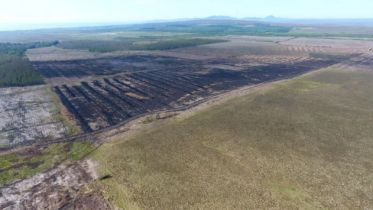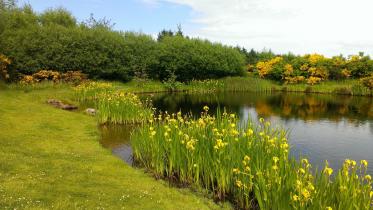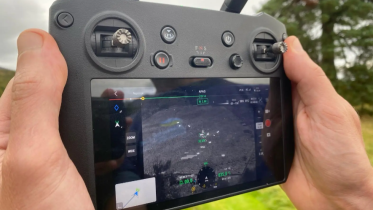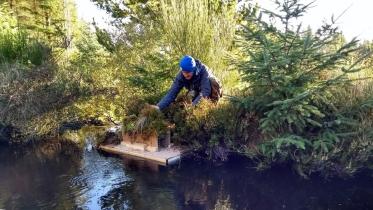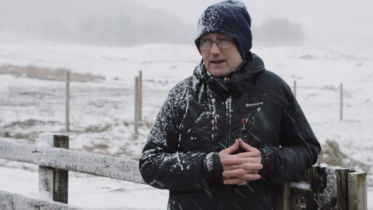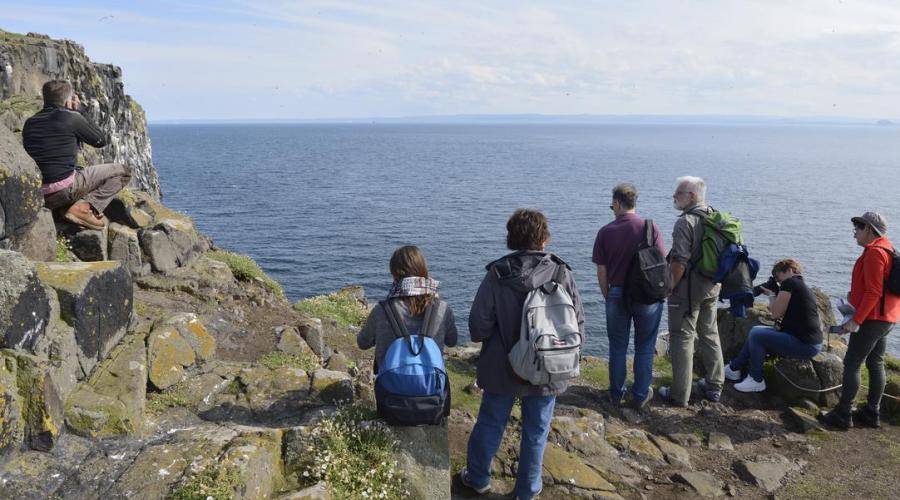
NatureScot's Gaelic Plan (2022-27)
Our Gaelic Plan sets out how we will use, develop and promote the language across our work.
Leugh ann an Gàidhlig / Read in Gaelic
Published: August 2022
NatureScot Gaelic Plan (3rd edition) 2022 - 2027
This plan was prepared under the Gaelic Language (Scotland) Act 2005 and was approved by Scottish Ministers on 24.06.2022
Foreword
There is an enduring bond between Scotland's nature and Gaelic, with the language giving us a unique insight and understanding of the world around us. In this third edition of our Gaelic Language Plan we seek to celebrate the connections between our natural, cultural and linguistic heritage. As we build on our achievements and strengthen our use of Gaelic, we will continue to encourage people to explore the language and its richness.
Like other Scottish Government bodies we have a responsibility to deliver the objectives of the National Gaelic Language Plan 2018-2023. Our own Gaelic Language Plan sets out how we will use, promote and develop the language, ensuring that it is intrinsic to many of our projects.
In previous editions of our plan we have endeavoured to increase our recognition of the language, actively enabling its use in our business and communications, through work such as our popular 'Gaelic in the Landscape' series and outdoor youth projects. We will continue to work with our stakeholders to develop and diversify these initiatives.
By celebrating Gaelic's importance to our understanding and appreciation of our natural environment, our new plan will inspire people to protect, restore and value nature.
Francesca Osowska, Chief Executive
About NatureScot
NatureScot is Scotland’s nature agency with 30 years’ experience advising the Scottish Government. We work to improve our natural environment in Scotland and inspire people to care more about it.
We believe that a nature-rich future, where everyone is involved, will make us all happier, healthier and more equal. We want our natural world to be at the heart of the nation’s well-being. NatureScot is focused on creating a nature-rich future for all, tackling biodiversity loss and the climate emergency with large and small scale nature-based solutions.
Most of our funding comes from the Scottish Government’s Environment and Forestry Directorate as ‘grant in aid’. Our success in caring for Scotland’s nature relies greatly on how we work with others across government. We also have joint working agreements and informal partnerships with a wide range of organisations.
Our 2022-26 corporate plan sets out our priorities over the next four years to:
- Protect nature by expanding protected areas, regulating species management, and delivering effective planning advice on land and at sea
- Restore nature through a new biodiversity strategy, restoring peatlands, aiding nature’s recovery and transforming farming
- Value nature so that the many benefits it provides to society can in turn attract public, private and social enterprise financing for both protection and restoration.
Working in collaboration, and viewing nature as part of wider social and economic challenges and opportunities, is central to our approach - for example, in tackling climate change and nature together.
For more information about our work, please see our website.
Gaelic within NatureScot
Over the past five years, we have worked to use, promote and develop Gaelic through the second edition of our Gaelic Plan (2016–2021) and supporting projects. Here are some examples of our initiatives:
Publications
Our series of place-name books grew to include research into place-names of Colonsay and Oronsay, Eriskay and Inverness and Surrounding Area. We also worked in partnership to create a guide to responsible foraging and bespoke teaching aids for Gaelic education. In 2018/19, we used these materials to deliver foraging workshops for nearly 200 Gaelic primary school pupils.
Communications
We have recorded dozens of TV and radio interviews in Gaelic, as well as regular bilingual blog posts and various news releases. Our campaign Freshspace, inspiring young women to get outside, produced a series of 10 short Gaelic videos and a resource pack. In 2019 we ran an extensive bilingual consultation when gathering views on possible Nature Conservation Marine Protected Areas.
National Nature Reserves (NNRs)
Fourteen of our national natural reserves have bilingual leaflets and seven reserves have complete dual-language duoliths. In partnership with Fèis Rois we have continued to host Ceilidh Trail performances at a number of reserves each summer and in 2020 ran a unique competition, In Tune With Nature, that encouraged entrants to connect with nature by writing music inspired by one of ten NNRs across Scotland.
Arts and culture
We have celebrated the intrinsic link between people and nature with performances as part of the Royal National Mòd. Most recently, we worked with renowned Gaelic-singer Mary Ann Kennedy on Clyde – A River Recovery (Dunoon 2018) and Lorg Ghlaschu – In Search of the Dear Green Place (Glasgow 2019). Inspired by the Year of Coast and Waters in 2020, we commissioned acclaimed traditional musician Ingrid Henderson to create Message in a Bottle, a new musical composition inspired by the movement of ocean currents.
Research
We have funded corpus-based research and development of Gaelic names, and associated terminology, for species without known titles. This produced 170 recommended names for ferns and their allies and marine molluscs. In 2020 we commissioned a scoping exercise examining the relationship between ecosystem services and the Gaelic heritage of Scotland.
Internal Gaelic Capacity Audit
We conducted an internal Gaelic capacity audit in June and July 2016. We received 134 responses and identified 3 fluent speakers within the organisation and 36 members of staff with a basic understanding of the language.
This survey has given us a benchmark for the level of Gaelic language skills, awareness and interest within NatureScot. We are committed to completing another such audit within the first year of this plan, and every three years thereafter. We will track survey results in order to monitor progress, opportunities and challenges.
Gaelic in Scotland
According to the 2011 Census around 87,000 people aged 3 and over in Scotland (1.7% of the population) have some Gaelic language skills. Highland, Eilean Siar and Glasgow City were the council areas with the largest numbers of people with Gaelic language ability1. The Census also showed that approximately 50% of Gaelic speakers live in the Highlands and Islands, and 50% across the rest of the country2.
Gaelic medium education is available in a number of local authorities, enabling young people to progress from early years into primary and secondary education. In the school year 2020/21 there were 6,272 pupils in Gaelic medium education. In addition to this, there were 75 English medium primary schools providing Gaelic language education as an additional language and 3,599 secondary pupils were studying Gaelic as a subject3.
Over 50 public authorities in Scotland have Gaelic language plans. These plans set out how organisations will use, and enable the use of, Gaelic in relation to their main business functions.
The Gaelic Language (Scotland) Act 2005
The Gaelic Language (Scotland) Act 2005 was passed by the Scottish Parliament with a view to securing the status of Gaelic as an official language of Scotland, commanding equal respect to the English language.
One of the key features of the 2005 Act is the provision enabling Bòrd na Gàidhlig to require a public authority to prepare a Gaelic language plan. This provision was designed to ensure that the public sector in Scotland plays its part in creating a sustainable future for Gaelic by raising the status and profile of the language and creating practical opportunities for its use.
This document is NatureScot’s third edition Gaelic Plan prepared within the framework of the Gaelic Language (Scotland) Act 2005, having regard to the National Gaelic Language Plan and the Guidance on the Development of Gaelic Language Plans. It sets out how we will use Gaelic in the operation of our functions, how we will enable the use of Gaelic when communicating with the public and key partners, and how we will promote and develop Gaelic.
The National Gaelic Language Plan
NatureScot supports the aim of the National Gaelic Language Plan 2018 - 2023 that “Gaelic is used more often, by more people and in a wider range of situations”.
We are committed to achieving this aim by focussing our work on:
- Increasing the use of Gaelic within our organisation and encouraging more people to use Gaelic more often when they interact with us
- Increasing the opportunity for people to learn Gaelic as part of our day-to-day operations
- Promoting a positive image of Gaelic whenever we can as part of our day-to-day operations as an organisation.
Draft Gaelic Plan Consultation
Under the 2005 Act, we are required to consult on our draft Gaelic Plan prior to submission to Bòrd na Gàidhlig. To do so, we made our draft Gaelic Plan available on our website and ran a six-week consultation with the public and NatureScot staff between May and July 2021.
Once feedback from the consultation had been received and resulting changes made, we submitted a final draft of our Gaelic Plan to Bòrd na Gàidhlig for approval. The draft plan was referred by Bòrd na Gàidhlig to Scottish Ministers.
Further information about the public consultation can be found in Appendix 1.
Key Principles
We are committed to applying the following key principles across our Gaelic Plan and supporting projects:
Equal respect
We will ensure that where Gaelic is included as part of our operations and services, it is of an equal standard and quality as those that we provide in English.
Active offer
We will make an active offer of our Gaelic services to our employees and the public. This will ensure that where Gaelic services are made available by us, users will be made aware of their existence and uptake will be actively encouraged. This will take the responsibility away from the individual to ask for the service and will give Gaelic users the confidence to know that their needs will be met if that is their choice. We will ensure that our Gaelic language services are as accessible as our English language services.
Mainstreaming
We will ensure that opportunities for the public and our staff to use Gaelic are normalised, in support of the National Gaelic Language Plan 2018 - 2023 aim that "Gaelic is used more often, by more people and in a wider range of situations".
High-Level Aims
We worked with Bòrd na Gàidhlig to set six high-level aims for this edition of our Gaelic Plan. These are strategic actions closely linked to the National Gaelic Language Plan 2018 - 2023.
High-level aim: Support Gaelic communities to connect with and enjoy nature
Current practice: We have invested in a range of resources and initiatives to encourage Gaelic speakers and learners to foster a greater connection with nature. This includes our education packs for schools and our use of Gaelic in publications and with the media.
Action required:
- We will increase our use of Gaelic in community outreach and project work on climate change and biodiversity loss by 20% annually.
- By the end of this plan, we will use Gaelic in all such work undertaken in areas where at least 20% of the local population have Gaelic skills and within communities delivering Gaelic medium education.
- We will increase the volume of engaging Gaelic content, in a variety of formats, for both internal and external audiences to promote a greater awareness of Gaelic’s intrinsic connection with our natural heritage.
Target date: From Year 1
High-level aim: Encourage a greater understanding of the important and unique connection between nature and people through Gaelic language and culture.
Current practice: We have established a number of successful partnerships that celebrate Gaelic’s inextricable link with nature, for example our various school resources and place-name publications. We also have long-standing success in celebrating nature through Gaelic arts’ collaborations, such as Caithream na Cruinne with Fèis Rois and Royal National Mòd commissions.
Action required:
- We will continue to work in partnership with organisations and community groups to scope, develop and deliver projects that use Gaelic language and culture to enrich people’s connection to nature.
Target date: From Year 1
High-level aim: Identify research opportunities to grow and preserve our understanding of the natural environment through Gaelic.
Current practice: We invest in research that highlights the importance of Gaelic language and culture to our understanding of, and appreciation for, nature. Our Gaelic in the Landscape series investigates people’s close connection with the land, examined through place-names and folklore. We have also supported the research and creation of proposed standard names, and associated terminology, for ferns and their allies and marine molluscs. Through the From The Bird’s Mouth partnership project we are adding new Gaelic names for species which were un-named. We also commissioned and published a scoping exercise into Gaelic and ecosystem services.
Action required:
- Through partnership working we will continue to proactively establish research projects that increase our knowledge of Gaelic’s inseparable link to our natural environment and Gaelic.
- We will take forward recommendations made in our ecosystem services scoping exercise.
Target date: From Year 1
High-level aim: Create opportunities for Gaelic speakers to undertake foundation apprenticeships, modern apprenticeships and graduate placements within NatureScot.
Current practice: Our new Programme for Youth Employment is an exciting opportunity to develop nature-based skills for the future and to increase the number of young employees in our organisation. All vacancies within our programme identify Gaelic as a desirable skill.
Action required:
- We will seek opportunities within the Programme for Youth Employment placements to support the delivery of our Gaelic Plan and supporting projects.
- We will publicise information about vacancies in Gaelic and encourage Gaelic speakers to apply for roles.
- We will make Gaelic language classes and Gaelic awareness training available to all employees of the programme.
- In broader support of employment and skills in the nature-based sector, we will promote the benefits of Gaelic to nature-based jobs needed in the transition to a net-zero economy. Skills are needed across a range of nature-based sectors, many of which are focused in predominantly Gaelic-speaking areas.
Target date: From Year 2
High-level aim: Establish and maintain a Gaelic implementation group
Current practice: A number of colleagues across NatureScot assist with the development and implementation of our Gaelic Plan and supporting projects.
Action required:
- We will encourage participation from colleagues across all of our activities and areas in our new Gaelic implementation group.
- We will establish a clear remit for the group, based on developing, implementing and monitoring our plan’s commitments, and will meet every six months.
Target date: From Year 1
High-level aim: Normalise the inclusion of Gaelic within NatureScot funding schemes
Current practice: Our funding schemes help land managers, charities and others to contribute to looking after Scotland’s nature and landscapes. The Natural and Cultural Heritage Fund has supported new opportunities to promote scenery, wildlife and culture of the Highlands and Islands. Applicants were asked to demonstrate how projects would take Gaelic into account and Bòrd na Gàidhlig was represented on the fund’s Performance Management Board. We made fund guidance available in Gaelic and continue to use Gaelic in news releases and other communications about the fund.
Action required:
- Applicants to new rounds of funding will be asked to describe, where relevant and appropriate, their project’s use and promotion of Gaelic.
Target date: From Year 1
Core Commitments
Our core commitments set out the minimum level of Gaelic language provision that we will provide over the lifetime of this plan, and commitments from our previous Gaelic Plans remain as appropriate. We are committed to sharing this provision with organisations co-located within our workspaces.
Status
Current practice
- Fixed signage at our corporate offices generally appears bilingually
- External fixed signage appears bilingually at some area offices
- Temporary signage at Great Glen House is bilingual
- Some National Nature Reserves (NNRs) have bilingual signage
| Action | Target date | Responsibility |
|---|---|---|
|
Logo |
|
|
|
Fixed signage (internal and external) |
|
Communications Team |
|
Temporary signage |
|
Workplace Facilities and Services Communications Team |
|
National Nature Reserve (NNR) signage |
|
Communications Team |
Communicating with the public
Current practice
- Our contact us webpage highlights that we welcome Gaelic correspondence
- Correspondence made in Gaelic is directed to our Gaelic Officer
- We respond to all Gaelic communications in Gaelic
- Our Great Glen House reception desk has a notice to inform people that Gaelic may be used
- A bilingual email disclaimer accompanies all NatureScot emails
- Bilingual email signatures and out-of-office templates are available on our intranet
- We use bilingual headings on our templates for memos and other documents
- Our complaints’ procedure is in Gaelic
| Action | Target date | Responsibility |
|---|---|---|
|
Reception We will make further opportunities to learn Gaelic available to reception staff who wish to enhance their language skills. We will encourage and assist reception staff to use a bilingual greeting when welcoming visitors. Where Gaelic-speaking reception staff can provide a service, we will support them to do so and will actively promote this. |
Ongoing
Ongoing
Ongoing |
Workplace Facilities and Services |
|
Telephone We will make support available to staff to use bilingual greetings and voicemails, and encourage them to do so. |
Ongoing |
Workplace Facilities and Services |
|
Forms |
|
|
|
Public meetings |
|
|
Information
Current practice
- Our Gaelic Officer provides media interviews in Gaelic
- All news releases relating to our Gaelic Pan and supporting projects are bilingual
- We occasionally issue bilingual news releases for other stories
- We have a monthly bilingual blog post about different Gaelic and natural heritage themes, and periodically write blog posts relating to our Gaelic plan and supporting projects
- Our annual report and corporate plan are published bilingually, and our equality report has a bilingual foreword
- We have a Gaelic section on our website, which includes our Faclan Nàdair dictionary and other Gaelic resources
- Interpretation materials at some of our National Nature Reserves use Gaelic.
| Action | Target date | Responsibility |
|---|---|---|
|
News releases |
|
|
|
Social media |
|
|
|
Publications |
|
|
|
Marketing campaigns |
|
|
|
Website |
|
|
|
Exhibitions and events |
|
|
|
Interpretation |
|
Communications Team |
|
Internal communications |
|
|
|
Gaelic Tourism Strategy (2018 - 2023) |
|
Natural Resource Management |
|
Language utility |
|
|
Staff
Current practice
- Our Gaelic Officer post is designated ‘Gaelic essential’
- ‘Gaelic essential’ vacancies are advertised bilingually
- All vacancies state that Gaelic is a desirable skill
- We have run weekly Gaelic language classes at Great Glen House (Inverness) and Battleby (near Perth)
- We have run Gaelic Awareness and Gaelic in the Landscape sessions
| Action | Target date | Responsibility |
|---|---|---|
|
Recruitment We will designate one other post as “Gaelic essential”. Gaelic will remain recognised as a desirable job skill for all other posts. |
Year 5
Ongoing |
|
|
Induction |
|
Gaelic Officer |
|
Training We will provide regular Gaelic language classes, Gaelic awareness sessions and training on Gaelic and our natural heritage. This training will be provided in accordance with existing language skills and will utilise technology to make opportunities available to as many colleagues as possible.
We will make resources available to assist with Gaelic pronunciation, particularly in relation to place-names and landscapes.
Our Gaelic training opportunities will be available to colleagues during work hours. We will prioritise colleagues who deal directly with the public and those working in Gaelic-speaking island and rural communities. We will share these opportunities with partner organisations where capacity allows. |
Ongoing
Year 2
Ongoing |
People and Organisational Development |
Gaelic Language Corpus
Current practice
- All of our written communications follow the most recent Gaelic Orthographic Conventions
- We are a partner of Ainmean-Àite na h-Alba, the national advisor for Gaelic place-names in Scotland. We seek their advice on place-names and work collaboratively on projects.
This will remain unchanged during this plan’s duration.
Publication
Internal
To ensure that colleagues are aware of their duties to the plan and the opportunities it presents them, we will
- provide details of the plan on our intranet;
- create channels for engagement and collaboration;
- contact colleagues with specific actions for delivery of high-level aims and core commitments;
- promote opportunities for involvement.
External
We will publish our finalised plan in Gaelic and in English on our website. In addition, we will
- issue a bilingual press release announcing the approval and publication of our plan;
- publicise through our social media;
- inform relevant third-party organisations, explaining their role in the delivery of the plan;
- inform key Gaelic stakeholders.
Our Gaelic Plan Within NatureScot
Staff engagement
All NatureScot staff can contribute to the successful implementation of the plan. By establishing a Gaelic implementation group, we will more ably disseminate and implement our commitments to the language throughout the organisation.
We will continue to use our internal communication channels to engage with staff on matters relating to our Gaelic Plan and supporting projects. Furthermore, we will be proactive in supporting staff with specific responsibilities to the plan.
Resourcing
Our plan has been devised based on the current resources available to us. We may seek external funding opportunities to pursue individual projects.
Monitoring
We will produce a quarterly internal progress report and will complete an annual monitoring report for Bòrd na Gàidhlig. We will make this report available to the public via our website.
Third parties
We will seek to ensure that, where appropriate, agreements or arrangements made with third parties that relate to the delivery of services to the public, are shaped by the terms of this plan. Where the third party does not have a Gaelic plan, we will encourage it to follow ours.
Responsibility
Our Chief Executive has ultimate responsibility for ensuring that we deliver on the commitments set out in this plan.
Our Head of Communications, Cat Synnot, has overall responsibility for preparation, delivery and monitoring.
Our Gaelic Officer, has day-to-day responsibility for the delivery and monitoring of the plan. Queries regarding the day-to-day operation should be addressed to Robyn Ireland.
Appendix 1
Public consultation
We ran a six-week public consultation on our draft third edition Gaelic Language Plan from 25 May to 6 July 2021. The document was available bilingually on our website and we released a Gaelic and English news release to encourage people to submit their views. We also posted on Facebook and Twitter, and we emailed stakeholders.
We received seven responses – two from members of the public and five from other public organisations – and two small amendments were made to our draft plan.
References
1 National Records of Scotland, Scotland’s Census 2011: Gaelic report (part 1), p6
2 Bòrd na Gàidhlig, National Gaelic Language Plan 2018-23, p26
3 Bòrd na Gàidhlig, Gaelic School Data 2020-21
